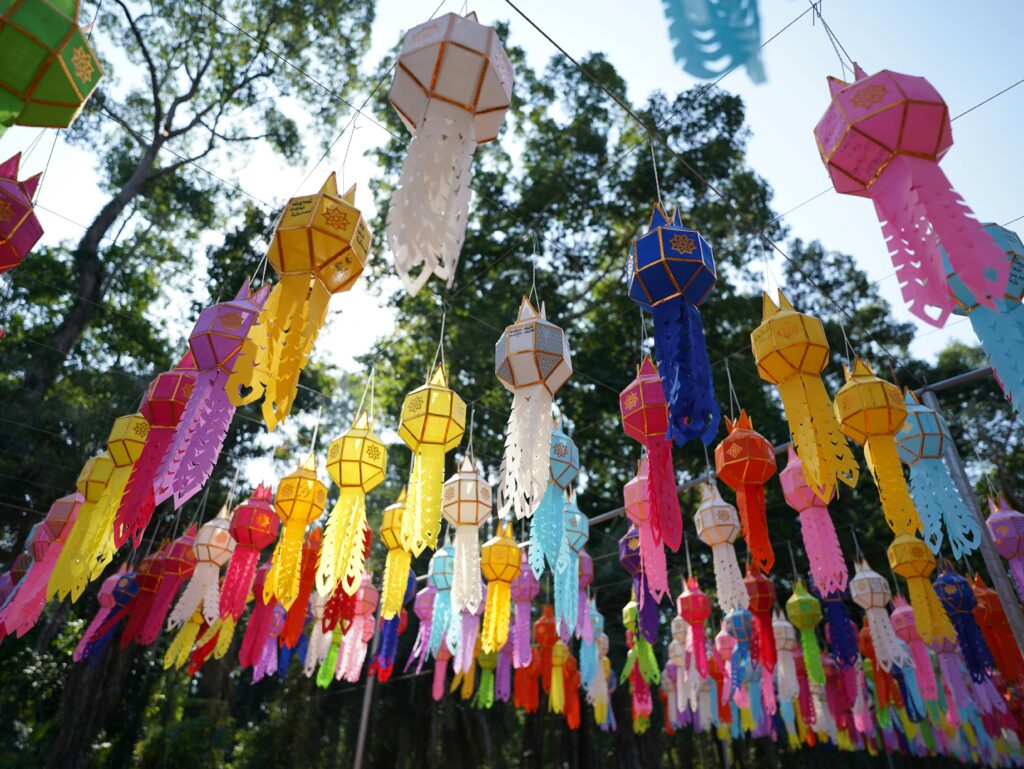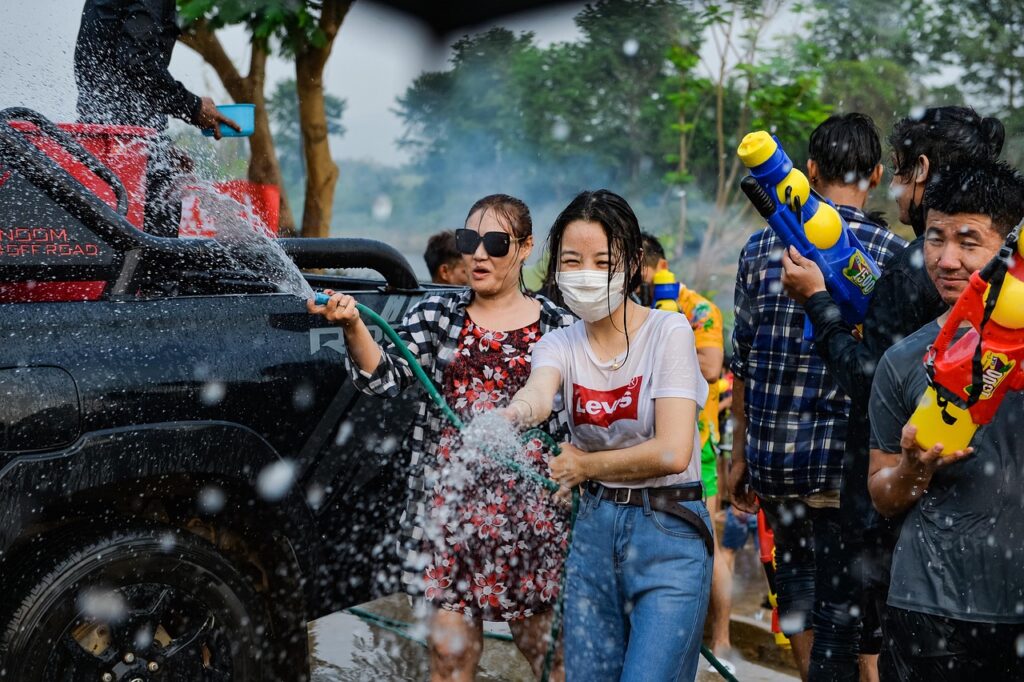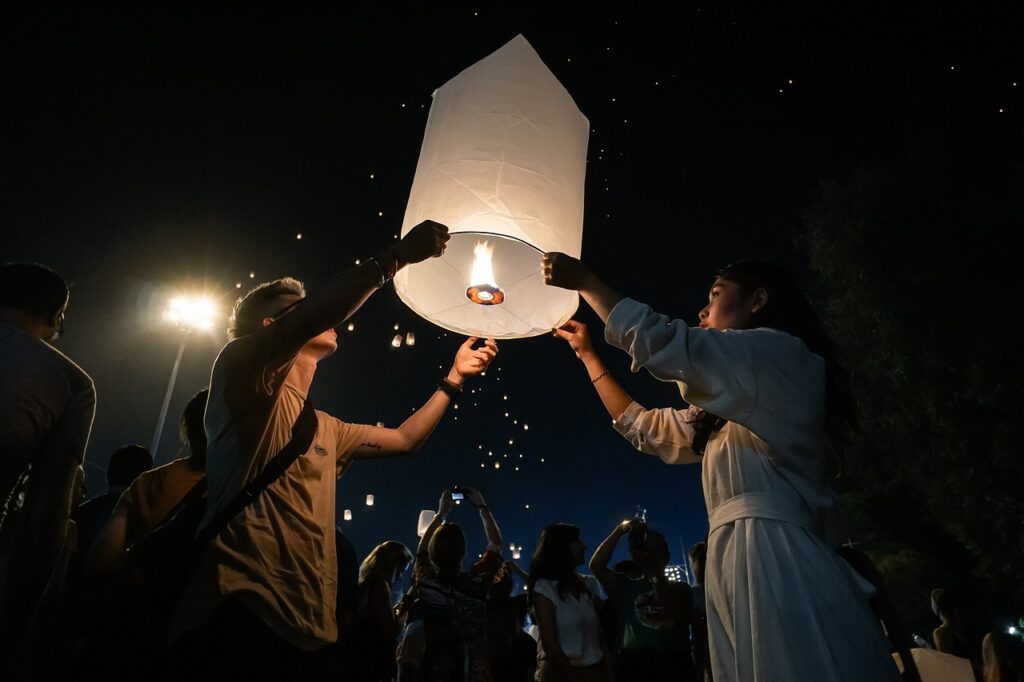Thailand, which is also known as the “Land of Smiles,”

Thailand entices tourists with its breathtaking beaches, elaborate temples, and mouthwatering food. However, beyond the well-traveled tourist routes is a rich cultural tapestry that is best appreciated during its enthralling local celebrations. We invite you to embark on a year-long journey through Thailand, discovering its heart and soul one spectacular festival at a time. Forget generic itineraries. This month-by-month guide will give you a genuine and unforgettable look into this enchanted kingdom by revealing the distinctive festivities that make up the Thai calendar.
January: Exploring Local Customs and the Cool Season
January in Thailand offers pleasant, cooler temperature that are ideal for exploring, even though much of the world is freezing. This is an excellent time to observe regional customs and merit-making ceremonies, even though there aren’t any national mega-festivals.
Local Temple Fairs: During the cooler months, a lot of temples in Thailand hold smaller fairs. Local food vendors, customary games, merit-making opportunities, and occasionally even brief performances are all common features of these gatherings. Inquire with locals about temple events in the places you’re visiting or look for banners.
Chinese New Year preparations, which take place in Chinese communities in late January or early February: Although February is usually when the major festivities take place, you’ll notice preparations and a joyous mood in Thailand’s thriving Chinese communities, especially in Bangkok’s Chinatown.
February: Colors, Flowers, and Spiritual Observances
February often brings a burst of color and marks important religious dates.
In addition to significant religious holidays, February frequently brings splashes of colors.
Chiang Mai Flower Festival (early February, Chiang Mai): This famous festival in Northern Thailand offers a stunning display of colorful blooms. Traditional music and dancers accompany the elaborate floral floats as they parade through the city. It’s a photographer’s paradise and a feast for the senses.
Cultural Significance: Honors the area’s natural beauty and bountiful harvest.
Traveler Tip: Because this is a well-attended event, reserve lodging in Chiang Mai well in advance.
Makha Bucha Day: Usually observed nationwide in February or March, this important Buddhist holiday honors a crucial moment in the life of the Buddha. Be prepared to witness pious Buddhists attending sermons, candlelit processions (wian tian), and merit-making ceremonies at temples.
Cultural Significance: A profoundly spiritual day that emphasizes kindness and peace.
Travel Tip: Be aware of the solemn atmosphere and dress appropriately when visiting temples. Sales of alcohol are frequently prohibited on this day.
March: Old Traditions and the Heat Starts
Some intriguing regional customs emerge as the weather warms up.
Poy Sang Long Festival, which takes place in Mae Hong Son Province in March or April: The ordination of young Shan (Tai Yai) boys as novice monks is celebrated during this colorful and distinctive festival. In a vibrant display, the boys are paraded through the streets wearing intricate costumes.
Cultural Significance: An important Shan rite of passage that demonstrates religious devotion and camaraderie.
Traveler Tip: This festival provides a unique opportunity to experience Northern Thailand’s Shan customs.
April: The Exciting Songkran Water Battles

One of Thailand’s most well-known and thrilling celebrations takes place in April.
Songkran (Thai New Year, April 13–15, nationwide): Get ready to get wet! Songkran is a festive occasion that commemorates the traditional Thai New Year. Splashing water represents the beginning of a new year and the removal of bad luck. The most noticeable feature is the water fights, but there are also significant religious rituals and family get-togethers.
Cultural Significance: respecting elders, cleaning, and renewal.
Traveler Tip: Expect to get soaked! Respectfully participate in the fun while keeping your electronics safe. Bangkok and Chiang Mai are renowned for their especially exuberant festivities.
May: The Beginning of the Rainy Season and Royal Ceremonies
Important royal ceremonies and the slow start of the rainy season are frequently held in May.
The traditional beginning of the rice-growing season is marked by the Royal Ploughing Ceremony
(Phra Ratchaphithi Charot Phutthamonkhon), an ancient Brahman ritual that typically takes place in May in Bangkok. Members of the royal family attend this important event, which includes predictions for the harvest this year and a symbolic plowing.
Cultural Significance: A combination of royal ceremony and agricultural tradition that emphasizes the value of rice cultivation.
Traveler Tip: Observing this ceremony provides a unique perspective on Thai royal customs, even if you are unable to take part directly.
June: Local Festivities and Verdant Sceneries
As the rainy season begins, June brings with it verdant landscapes. It’s a terrific time to visit the countryside and take in local events, even though there may not be as many major festivals.
Local Village Fairs in Thailand: There are still smaller village fairs and temple events, much like in January. These frequently include regional specialties and provide genuine insights into local life.
July: Buddhist Lent Begins and Candle Festivals
In July, the Buddhist Lent, a three-month period of increased religious observance for monks, begins. Asanha Bucha Day and Khao Phansa (usually July, Nationwide): Asanha Bucha commemorates the Buddha’s first sermon, while Khao Phansa marks the start of the monastic retreat. Expect to see merit-making activities and a more contemplative atmosphere in temples.
Cultural Significance: Important Buddhist holidays that emphasize monastic discipline and spiritual reflection.
Traveler Tip: Show extra reverence when visiting temples during this time.
Typically held in July, the Ubon Ratchathani Candle Festival is a magnificent event in Northeastern Thailand that showcases intricately carved wax sculptures, frequently portraying scenes from Buddhist mythology. Before being shown to temples, these magnificent works are paraded through the streets.
Cultural Significance: A distinctive artistic custom and a means for the locals to give to the temples at the beginning of Buddhist Lent.
Traveler Tip: Offering a genuinely unique festival experience, Ubon Ratchathani is a little off the usual tourist route.
August: Local Celebrations and Mother’s Day
Her Majesty Queen Sirikit The Queen Mother’s birthday, also known as Mother’s Day, is celebrated in Thailand in August.
Mother’s Day Celebrations (August 12th, Nationwide): Mothers will be honored nationwide with celebrations. Special events are held by numerous companies and organizations.
As previously stated, the Ghost Festival (Phi Ta Khon) in the Dan Sai district of Loei province is a colorful and distinctive masked celebration that typically takes place in June or July but occasionally lasts into early August. Verify the precise dates for the year you plan to travel.
September: The Green Season’s High Point
With fewer significant festivals, September is usually the wettest month. But the scenery is extraordinarily verdant and lush, providing a distinct kind of beauty. For those who enjoy the outdoors and want a more sedate vacation, now is a good time.
October: Buddhist Lent Comes to an End and Joyful Celebrations Return
Buddhist Lent comes to an end in October, bringing with it lively customs and new festivities.
The monks’ retreat comes to an end on Ok Phansa, which is the end of Buddhist Lent and typically falls in October nationwide. A return to a more joyous ambiance and merit-making ceremonies are to be expected.
Following Ok Phansa, the unique festival known as Chak Phra (Dragging of the Buddha Image Festival, Southern Thailand, especially Surat Thani and Nakhon Si Thammarat) features elaborately decorated floats carrying Buddha images being paraded and occasionally even pulled by boats along rivers.
Cultural Significance: Involves active community participation and commemorates the Buddha’s return from the heavens.
Traveler Tip: This provides insight into the unique Buddhist traditions of Southern Thailand.
November: Loy Krathong and Yi Peng’s “Lights Illuminate the Night”
Thanks to two captivating festivals, November is undoubtedly one of the most aesthetically spectacular months to travel to Thailand.
Loy Krathong (typically observed nationwide in November): Thai people float exquisitely adorned krathongs—small floating offerings made of banana leaves, flowers, candles, and incense—on rivers, lakes, and canals on the full moon night of the twelfth lunar month. It’s a symbolic way to honor the water goddess and let go of negativity.
Cultural Significance: Asking the water goddess for forgiveness, letting go of bad luck, and wishing for the future.
Traveler Tip: Make your own krathong or buy one to participate politely.

Yi Peng Lantern Festival (usually held in November in Chiang Mai): Yi Peng is especially spectacular in Chiang Mai, even though it is frequently celebrated around the same time as Loy Krathong. A magnificent show of floating lights is produced when thousands of paper lanterns, or khom loi, are released into the night sky.
Cultural Significance: Casting anxieties and misfortunes into the sky.
Traveler Tip: Because it can get crowded, find a good viewing location in advance. When releasing lanterns, keep safety in mind.
December: Year-End Celebrations and a Festive Spirit
As the year comes to an end, December offers a festive atmosphere and cooler temperatures.
King Bhumibol Adulyadej Memorial Day is observed nationwide on December 5th and serves as a day to honor and remember the late King. Anticipate a respectful environment and commemorative activities.
Despite not being a traditional Thai holiday, Christmas is widely observed, particularly in tourist areas, with decorations and special events on December 25th.
Thailand celebrates New Year’s Eve (December 31st, nationwide) with fireworks, parties, and countdown events in major cities like Bangkok and Chiang Mai.
Organizing Your Festival-Focused Vacation: To fully immerse yourself in Thailand’s festivals:
Examine Particular Dates: Every year, festival dates can change, particularly those connected to the lunar calendar. Examine local event calendars and official tourism websites ahead of time. Make reservations for lodging and transportation in advance, particularly for well-known celebrations like Songkran, Loy Krathong, and the Chiang Mai Flower Festival.
Be respectful: Recognize the festivals’ cultural and religious significance and act and dress appropriately, particularly when at temples.
Accept the Experience: Keep an open mind to new sounds, sights, and customs. Ask locals about the significance of the festivities.
You’ll develop a greater understanding of Thailand’s rich culture, friendly people, and the eternal spirit of the “Land of Smiles” if you go beyond the usual tourist route and immerse yourself in the colorful tapestry of local festivals. Plan your festival-filled journey now!
You may also like:
- Top 10 Best Beaches in North America
- Ultimate 2025 Guide: To Enjoy Tulip Season in the Netherlands
- Trump Travel Ban- Impact on 80K international students in Texas.
- Overseas Adventure Travel 2025: Your Ultimate Guide to Thrilling Journeys



